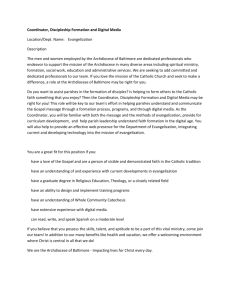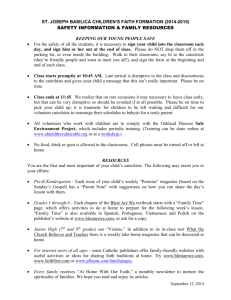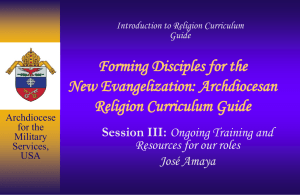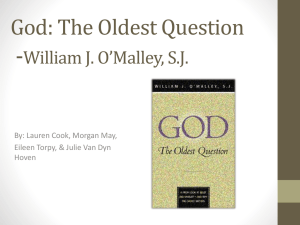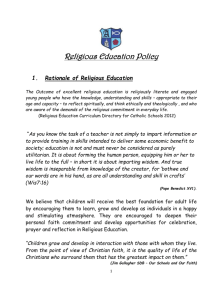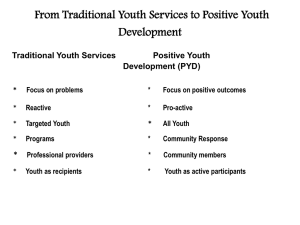Dr. Harry Dudley - Archdiocese for the Military Services, USA
advertisement
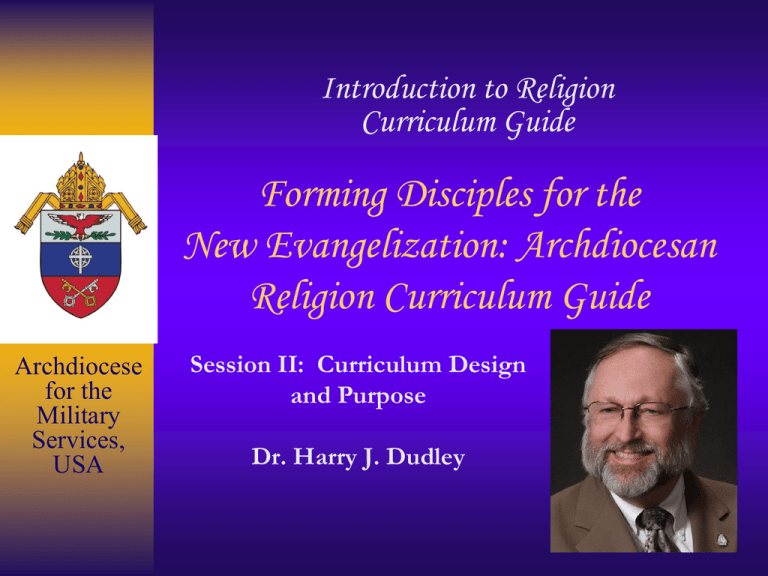
Introduction to Religion Curriculum Guide Forming Disciples for the New Evangelization: Archdiocesan Religion Curriculum Guide Archdiocese for the Military Services, USA Session II: Curriculum Design and Purpose Dr. Harry J. Dudley Key questions and concepts… How was this guide created? What is it? How is it better? What are the implications for textbooks? What is the aim of this guide? How was this guide created by the Archdiocese of Washington? Principles embodied in the development process: Communication, Consultation and Collaboration. – 11 member task force – 18 readers and subject areas experts – 21 programs piloted the curriculum with 250 parish and school catechists. – Approval at each stage by the Archbishop. What is it? The Standards and Indicators in this Guide clearly state what participants in every Catholic faith community religious education program must: – know, – understand and – do at each grade level (Pre-K to 8). This tool – although written with children in mind, also has implications for young adults and youth in the Archdiocese because it provides a common language and agreed upon standards for sharing the faith. Effort was made to incorporate the emphasis in Vatican II: Greater Understanding of – the Sacred Scriptures – Social Justice – Human Sexuality/Family Life/ Age Appropriate Theology of the Body – Evangelization – Ecumenism – Inter-religious dialogue and understanding. Forming Disciples for the New Evangelization is recommended because: Context for all catechesis is Evangelization Better connect faith and life Emphasis on the six key elements of a Catholic life Brief exercise Recall one truth of the faith that you learned as a child; what was it and how did you learn it? Bonus question: – What impact this truth had on your life? You may send your comments by chat. This chart shows the Key elements and standards and how they relate to the Four pillars of the Catechism of the Catholic Church. This chart shows how disciples’need to live out their faith in Community of the Church and in service to the World. How is this Guide different? This Guide will challenge all of us to grow because it is: – Standards-based – Tied to its own assessment – Spiral in scope and sequence What is meant by Standards-Based? In the field of education, a standard is a term which defines a cumulative body of knowledge and set of competencies that is the basis for quality education. They express what all program participants must know, understand and do at each grade level but do not dictate how they are to be taught. For Each Element For example: Key Element IV: Prayer There are standards or broad headings Each Standard Each standard in turn has indicators for each grade of knowledge, skills or behavior. As we look at the curriculum note: The numbering system: Grade, Standard and then indicators. 1.08.01 Underlining – means this is a vocabulary word to know. 1.08.01 means Grade: 1 Standard #8 Indicator # 1. Indicators These indicators are there to: – help us to focus our instruction and – guide our use of any texts or resources. This allows us to have a true alignment of language, instruction and assessment. A note about assessment Many people don’t believe that one should or can assess religious education efforts. It may be more proper to say that one can not assess faith. What can be assessed is how well one has learned the language, practices and general knowledge of the faith tradition. Why tie the Guide to its own assessment? When such an assessment is tied to a guide and offered by the Archdiocese: – Each program participant’s progress towards attaining the standards can be measured. – Those who are not achieving the standards can also be provided with early, effective assistance. – This is tied to our partnership with the family: catechetical leaders and catechists need to see themselves as accountable to the parents of those who are enrolled. This new assessment will help: To align language to be learned with assessment and instruction. To promote accountability because current assessments have been both inadequate and inconsistently done To measure our success. Because when an aligned assessment is offered by the Archdiocese, we can improve our instruction for all. Pause: Discuss among yourselves: How might be this new guide be a resource for the New Evangelization? - Send in your comments – so we can share them as best practice. What is meant by a spiral scope and sequence? The learners return to each topic each year, in an ever deeper fashion. By following the same sequence of ideas, one after the other, a learner has a better chance of retaining it! In a single Catholic faith community– all ages can be studying the same theme at the same time…homilies might also cover some of the same topics. Here are examples of how spiral scope and sequence works from Key Element VI What are the implications? Clear expectations for the teaching of the faith Accountability through assessment Greater opportunity for all the partners in the catechetical process to return to each topic each year in an ever deeper way by using the resources provided. What additional resources have been created to help in implementation? In the next session we will review what resources are being provided on the AMS website: for Catechetical Leaders for Catechists for Parents What does it mean for textbooks? No need to change textbooks. Use the USCCB Conformity List to select textbooks that meet the needs of your Catholic faith community. Textbooks will be reviewed in light of how well they align with AMS curriculum standards. The standards will help catechists to know what to focus on in the textbook. Publishers will do correlations of their series to the curriculum guide so everyone can clearly see when additional resources might be needed. Best resources will be collected, shared and made available on-line: www.milarch.org. What is the aim of this guide? – To support integrated planning and preparations across all sectors of the Archdiocese for the Military Services, USA including our communities and families. – Although this first phase of the guide focuses on the formation of children, these standards will also provide a framework for future efforts in the faith formation of adults and youth. Next steps today? The next presentation will: Review what resources will be available to help you, your catechists and families. Clarify expectations for each role. Give you opportunity: – to give input on what additional resources are needed for full implementation in the next program year starting August 6, 2013.
